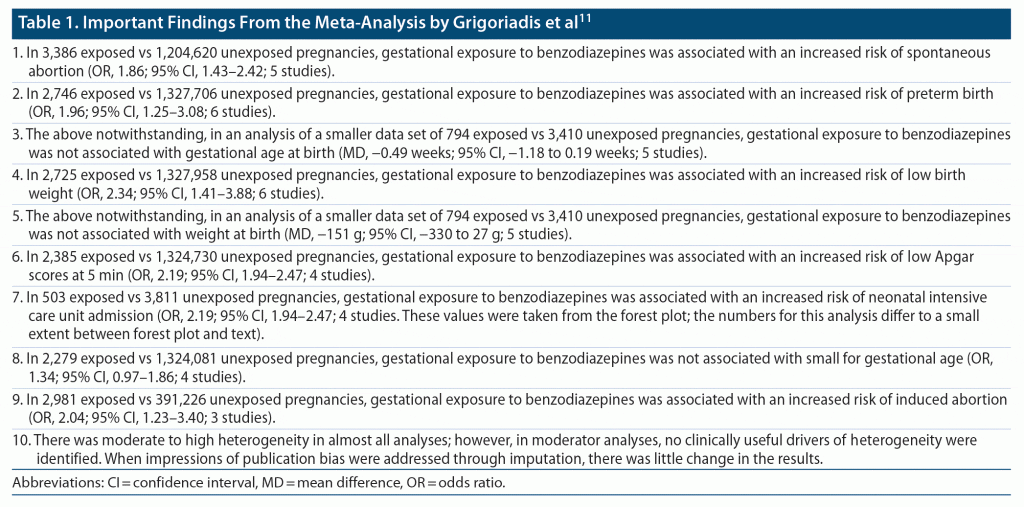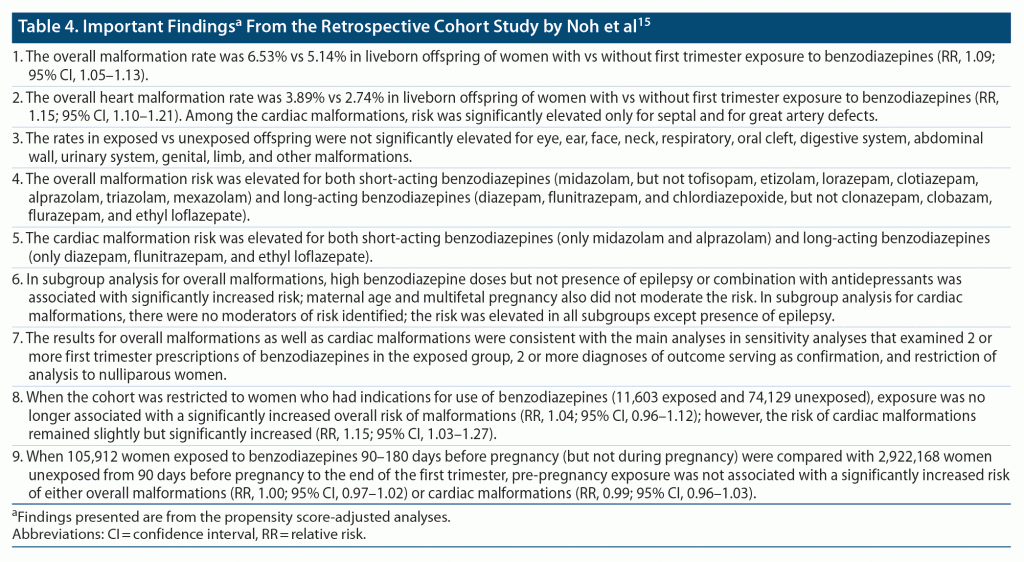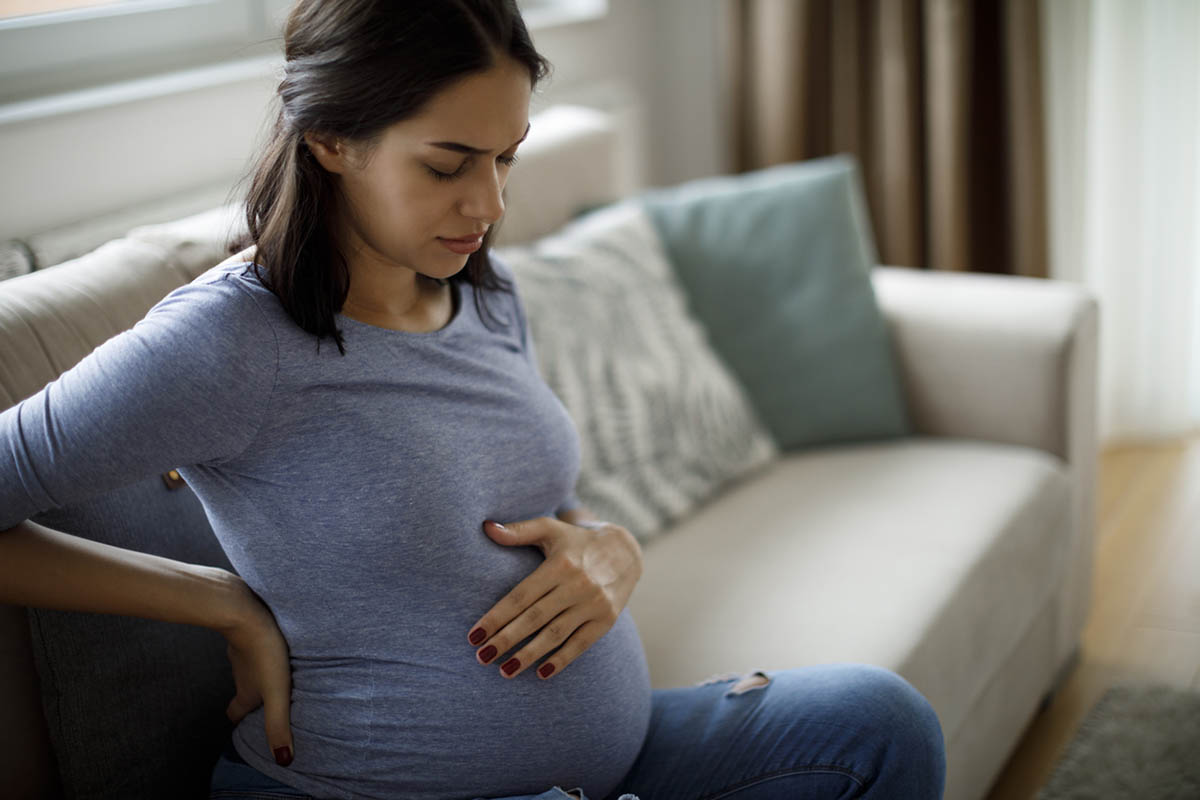ABSTRACT
A small proportion of women with anxiety, insomnia, and other conditions may require benzodiazepines or z-hypnotics intermittently or daily sometime during pregnancy. This article provides an update on pregnancy outcomes associated with pre-gestational or gestational exposure to benzodiazepines and z-hypnotics based on results from 2 meta-analyses, 2 registry-based studies, and 2 large retrospective cohort studies. In summary, the meta-analyses found that exposure was associated with an increased risk of spontaneous abortion, induced abortion, preterm birth, low birth weight, small for gestational age, low Apgar scores at 5 min, and neonatal intensive care unit admission. Whereas meta-analyses and registry studies found that first trimester exposure to benzodiazepines and/or z-hypnotics was not associated with increased risk of congenital malformations, a nationwide observational study with 10 times as many exposed pregnancies as in all the previous studies combined found that first trimester exposure to benzodiazepines was associated with a small but statistically significantly increased risk of overall malformations as well as, specifically, cardiac malformations; in this study, analyses that examined the potential role of confounding by indication suggested that the adverse findings may not have been due to confounding. Finally, a large observational study found that exposure to benzodiazepines in the 90 days before conception was associated with an increased risk of ectopic pregnancy; in this study, as well, the findings were consistent in analyses that examined possible confounding by indication. In no reviewed study could residual confounding be ruled out. The take-home message is that benzodiazepine and z-drug exposure before and during pregnancy is associated with many adverse gestational outcomes, but it is unclear to what extent the findings are due to exposure to drugs vs exposure to the indication for treatment. Therefore, all treatment decisions need to be tailored to context and shared between health care professionals, patients, and their caregivers.
J Clin Psychiatry 2023;84(2):23f14874
To cite: Andrade C. Gestational exposure to benzodiazepines and z-hypnotics and the risk of major congenital malformations, ectopic pregnancy, and other adverse pregnancy outcomes. J Clin Psychiatry. 2023;84(2):23f14874.
To share: https://doi.org/10.4088/JCP.23f14874
© 2023 Physicians Postgraduate Press, Inc.
Benzodiazepines may be prescribed during pregnancy for indications such as anxiety and insomnia; they may be taken on an as-needed basis or daily. Many studies have reported on the frequency of prescription, dispensation, or use of benzodiazepines during pregnancy. In this connection, an insurance database study in the US found that, during 2007–2015, 2.0% of women had received at least 1 benzodiazepine during pregnancy.1 In the 1999–2008 Norwegian Mother, Father, and Child Cohort Study, 0.8% of women had been exposed to benzodiazepines or a z-hypnotic during pregnancy.2 In Taiwan, benzodiazepine use during pregnancy fell from 4.1% in 2004 to 2.9% in 2017; however, stable use, defined as at least 0.5 defined daily doses, rose from 0.1% in 2004 to 0.4% in 2017.3 Overall, in Taiwan, between 2004 and 2017, 5% of women had been dispensed a benzodiazepine during pregnancy.4 A systematic review and meta-analysis of the global prevalence of benzodiazepine use (or prescription) during pregnancy, based on 32 studies from 28 countries, obtained a pooled prevalence for exposure of 1.9% overall, and 3.1% for the third trimester specifically.5
These rates are small, and the rates of actual use may be even smaller because pregnant women do not always take all doses of dispensed medications. Nevertheless, if gestational exposure to benzodiazepines carries an increased risk of adverse outcomes, the subject is of public health importance at a population level. Whereas the field has not been as well researched as anticonvulsant, antidepressant, or antipsychotic exposure during pregnancy, many studies examining many gestational outcomes of interest have been published in recent years.
Previous Research
Grigoriadis et al6 conducted a systematic review and meta-analysis of 8 studies that examined the risk of major congenital malformations (MCMs) associated with gestational exposure to benzodiazepines. They found a small increase in risk that narrowly missed statistical significance in the main analysis (odds ratio [OR], 1.13; 95% confidence interval [CI], 0.99–1.30); importantly, when first trimester exposure was specifically examined in 5 studies that provided the data, the risk was neither clinically nor statistically significant (OR, 1.08; 95% CI, 0.93–1.25). The risk, however, was clearly and significantly elevated in 3 studies of combined benzodiazepine and antidepressant exposure (OR, 1.40; 95% CI, 1.09–1.80). Of note, all studies that contributed data to the meta-analysis were observational in nature and had adjusted for non-benzodiazepine risk factors in various ways (or not), and so the effects of inadequately measured, unmeasured, and unknown confounding could not be ruled out.
Earlier articles in this column examined MCM and other risks associated with gestational exposure to benzodiazepines.7–9 Many new studies have now been published. This recent literature is critically examined in the present article.
Recent Studies
Recent studies were identified through a PubMed search conducted on March 8, 2023, with the search terms benzodiazepines and pregnancy, restricted to the first 170 hits; that is, to listings that extended to before the reviews referred to above.6–9 Articles were selected if they were original studies or meta-analyses that examined risks of adverse gestational outcomes after gestational exposure to benzodiazepines or z-hypnotics. Reference lists of identified articles were examined. Studies that were included in newly identified meta-analyses were not considered because the meta-analyses are discussed in this article. Studies that examined neurodevelopmental outcomes were also not considered because these were examined in the previous article in this column.10
The search identified 6 articles of interest. Two were meta-analyses,11,12 2 were registry-based studies,13,14 1 was a nationwide, population-based cohort study,15 and 1 was an insurance database study.16 Each is examined in turn and a qualitative synthesis is provided.
Meta-Analysis: Gestational Exposure to Benzodiazepines and Pregnancy and Delivery Outcomes
Grigoriadis et al11 described a systematic review and meta-analysis of pregnancy and delivery outcomes in cohort studies that compared pregnancies with and without benzodiazepine exposure. A search of electronic databases and reference lists identified 14 eligible studies that examined 9 outcomes of interest. These studies had been published between 1994 and 2018. Most of the studies had been conducted in Europe (n = 8) or North America (n = 5). One study was conducted in Asia.
Important findings from the meta-analysis11 are presented in Table 1. In summary, gestational exposure to benzodiazepines was associated with increased odds of spontaneous abortion, induced abortion, preterm birth, low birth weight, low Apgar scores, and neonatal intensive care admission. The findings for lower gestational age at birth, lower birth weight, and smallness for gestational age showed trends that did not reach statistical significance; 2 of these analyses may have been underpowered.
The findings of this meta-analysis11 must be interpreted with caution because some of the studies that contributed data presented unadjusted analyses, and none adequately addressed confounding by indication.
Meta-Analysis: Gestational Exposure to Hypnotic Drugs and Congenital Malformations and Other Pregnancy Outcomes
Grigoriadis et al12 described what is possibly the first systematic review and meta-analysis of congenital malformations and other pregnancy and delivery outcomes in cohort studies that compared pregnancies with and without hypnotic drug exposure. In this context, hypnotic drugs included not only the z drugs zopiclone, eszopiclone, zolpidem, and zaleplon but also benzodiazepines. A search of electronic databases and reference lists identified 7 eligible studies that examined 4 outcomes of interest. These studies had been published between 1999 and 2020. The studies had been conducted in Europe (n = 4), North America (n = 2), and Asia (n = 1). Most but not all studies presented adjusted analyses.
Important findings from the meta-analysis12 are presented in Table 2. In summary, first trimester exposure to hypnotic drugs, including benzodiazepines, was not associated with an increased risk of risk of congenital malformations. However, gestational exposure anytime during pregnancy was associated with a small increase in the odds of preterm birth, low birth weight, and smallness for gestational age. Limitations were that in most of the studies the number of exposed pregnancies was small; more importantly, only 3 studies adjusted for important confounders such as diagnosis and the use of other psychotropic agents.
US Registry-Based Study of Congenital Malformations
Using data from the prospective Massachusetts General Hospital National Pregnancy Registry, Szpunar et al13 compared 151 women (156 infants) with first trimester exposure to 1 or more benzodiazepine (clonazepam, 49%; lorazepam, 36%; alprazolam, 17%; diazepam, 3%; and temazepam, 2%) and 902 women (925 infants) unexposed to benzodiazepines. The mean age of the sample was 33 years. The sample was 93% white. About a third of women in each group were exposed to selective serotonin reuptake inhibitor drugs, and nearly a quarter in each group were exposed to second-generation antipsychotic drugs. Exposure to other neuropsychiatric drugs and to alcohol was also similar in the 2 groups. Prenatal vitamin use was slightly lower in the benzodiazepine group relative to the comparison group (69% vs 79%), but exposure to cigarettes (24% vs 8%) and illicit substances (13% vs 4%) was higher. The benzodiazepine group was overrepresented for a primary diagnosis of anxiety (27% vs 18%) and underrepresented for a primary diagnosis of depression (16% vs 27%).
The rates of major congenital malformations, identified within 6 months of birth, were 3.2% vs 3.5% in exposed vs unexposed women, respectively. In logistic regression, the crude OR was 0.92 (95% CI, 0.35–2.41). The statistical (non)significance did not change when each of 22 confounding variables was individually added to the crude regression model (the number of events was too small for all confounders to be simultaneously fitted into the model).
Important strengths of this study13 were that the study design controlled for presence of a mental health indication and that data were prospectively ascertained through interviews conducted at the time of enrollment during pregnancy, at 7 months of gestation, and at 12 weeks postpartum. An important limitation of the study is that the number of exposed women and hence the number of events (malformations) was small, limiting the power of the analysis and the ability to adjust for measured confounds.
Korean Registry-Based Study of Pregnancy Outcomes
Using data from the prospective Korean Mother-Safe Program, South Korea, Lee et al14 identified 96 vs 629 women exposed vs unexposed to alprazolam during pregnancy. The mean age of the sample was about 32 years. Exposed women had lower alcohol intake (27% vs 40%) but were similar to unexposed women in several other regards. Common reasons for use of alprazolam were irritable bowel syndrome, depression, anxiety, and “respiratory disease.” Defined daily doses of alprazolam ranged from 0.1 to 0.5 (median, 0.25), and cumulative doses during pregnancy ranged from 1 to 61 (median, 16) mg (stated as mg/kg by the authors). The last use of alprazolam was recorded at a gestational age that ranged from 1 to 12 (mean, 4) weeks. Delivery occurred at a mean of approximately 39 weeks.
The authors14 presented both crude analyses and analyses that were adjusted for 7 baseline covariates. Given that their sample was small and that the number of adverse outcomes recorded was even smaller, their adjusted analyses were vulnerable to overfitting.17 Therefore, only the results of the crude analyses are presented (Table 3). In summary, first-trimester gestational exposure to alprazolam was associated with an increased risk of many adverse pregnancy outcomes, but the findings are difficult to interpret because they are based on very small numbers of events and because adjustment for confounders could not validly be performed. Other serious limitations are that the authors did not provide information on other psychotropic and nonpsychotropic medications that women took during pregnancy, on rates of mental health disorders in exposed and unexposed women, and on rates of medical comorbidities in exposed and unexposed women. Finally, the dropout rate in exposed women (56%) was more than twice that in unexposed women (25%), laying the findings open to bias.
Korean Cohort Study of Congenital Malformations
In the largest single investigation on the subject to-date, Noh et al15 described a nationwide, retrospective cohort study of the risk of congenital malformations in liveborn offspring with first-trimester exposure to benzodiazepines. The data were drawn for the years 2009–2019 from the Health Insurance Review and Assessment Service database in South Korea. There were 40,846 women who had filled at least 1 benzodiazepine prescription specifically during the first trimester and 3,053,381 women who had not been prescribed benzodiazepines from 3 months before the last menstrual period to the end of the first trimester.
The mean age of the women was 32 years. Psychiatric conditions, medical comorbidities, psychotropic and nonpsychotropic drug use, and health care utilization were greater in exposed than in unexposed women, and so propensity score fine stratification adjustment was performed. Important findings from the study15 are presented in Table 4. In summary, first trimester exposure to benzodiazepines was associated with a small but statistically significantly increased risk of overall malformations and cardiac malformations. The risk was elevated with both short- and long-acting benzodiazepines, and higher doses were associated with greater risk. The findings were consistent in sensitivity analyses. Importantly, first trimester exposure to benzodiazepines was associated with increased risk of cardiac malformations (but not overall malformations) even when analyses were conducted only in women with indications for benzodiazepine treatment. Also importantly, pre-pregnancy exposure to benzodiazepines was not associated with increased risk.
These findings suggest that first trimester exposure to benzodiazepines rather than confounding by indication is associated with a risk of congenital malformations, including cardiac malformations, in offspring; the risk may be dose-dependent. An important limitation of this study is that it was restricted to liveborn offspring; so, malformations that resulted in spontaneous or voluntary termination of pregnancy were excluded from analysis (these could have biased the findings in either direction). Another important limitation is that, as with other studies of this nature, residual confounding, including confounding by severity of indication, could not be ruled out as an explanation for the findings.
US Cohort Study of Ectopic Pregnancy
Benzodiazepines have muscle-relaxant action and, in theory, may relax the smooth muscle of the fallopian tubes, slowing the transit of the fertilized egg toward the uterus, thereby predisposing to ectopic implantation. In this context, Wall-Wieler et al16 described a retrospective US cohort study of the rates of ectopic pregnancy in women who were vs were not exposed to benzodiazepines before conception.
The data were drawn from the IBM MarketScan Research Databases for 2008–2015. The sample comprised 1,691,366 pregnancies with 17,990 exposed and 1,673,376 unexposed to benzodiazepines. Here, exposure was defined as receiving at least 2 outpatient benzodiazepine prescriptions for at least 10 days of supply during the 90 days before the estimated date of conception. Baseline differences between groups was addressed through high-dimensional propensity score adjustment with inverse probability of treatment weighting. The analyses adjusted for a very large number of covariates, including known risk factors for ectopic pregnancy.
Important findings from the study16 are presented in Table 5. In summary, preconception exposure to benzodiazepines was associated with a small (by 0.8%) but statistically significant increase in the risk of ectopic pregnancy; importantly, this finding remained significant when confounding by indication was partially addressed in analyses restricted to women with a diagnosis of anxiety and those with a diagnosis of insomnia in the year before conception. The finding remained significant in sensitivity analyses, as well, that examined more loose and more strict definitions of benzodiazepine exposure. An important limitation of this study is that the date of the last menstrual period and the date of conception were estimated by algorithms that may not have been accurate. Another important limitation is that, as with other studies of this nature, residual confounding, including confounding by severity of indication, could not be ruled out as an explanation for the findings.
Interlude
One other study of the use of benzodiazepines in pregnancy was identified.18 This was a small (n = 50) randomized controlled trial of a single dose of midazolam (0.0125 mg/kg), compared with normal saline, administered intravenously before spinal anesthesia for cesarean section. Midazolam was associated with a small but statistically significant reduction in anxiety, as measured using a visual analog scale; and midazolam was not associated with lower 1 and 5 min Apgar scores, nor with impairment in maternal consciousness and recall of the moment of delivery.
Synthesis
From the meta-analyses by Grigoriadis et al,11,12 it appears that gestational exposure to benzodiazepines and/or z-hypnotic drugs is associated with an increased risk of many adverse pregnancy outcomes, including spontaneous abortion, induced abortion, preterm birth, low birth weight, small for gestational age, low Apgar scores at 5 min, and neonatal intensive care unit admission.
The meta-analyses by Grigoriadis et al6,12 and 2 small registry-based studies13,14 found that first trimester exposure to benzodiazepines and/or z-hypnotics was not associated with a significantly increased risk of congenital malformations. However, in sharp contrast, the large nationwide cohort study by Noh et al15 found that first trimester exposure to benzodiazepines was associated with a small but statistically significantly increased risk of overall malformations and cardiac malformations; the confidence intervals were narrow, suggesting precision, and the findings were consistent in subgroup and sensitivity analyses. Furthermore, in this study,15 analyses that examined the potential role of confounding by indication suggested that the adverse findings may not have been due to confounding. Considering that the number of exposed pregnancies in this single study was more than 10 times the combined exposure in all the other studies, much weightage must be given to its findings.
Finally, a large observational study found that exposure to benzodiazepines in the 90 days before conception was associated with an increased risk of ectopic pregnancy.16 The findings were consistent in subgroup and sensitivity analyses. The findings were also consistent in analyses restricted to women with anxiety and insomnia, suggesting that confounding by indication was not responsible. A cautionary note is that the findings of this single study need to be replicated.
Comments and Concluding Notes
All of the findings presented in this article emerged from observational studies of women who were vs were not exposed to benzodiazepines before or during pregnancy. Observational studies are not randomized controlled trials, and so influential sociodemographic, psychosocial, illness, comorbidity, comedication, and other variables are often poorly balanced between exposed and unexposed groups. Statistical procedures can help adjust for such variables, but measured variables that are adjusted for are often not ideally measured and so are not ideally adjusted for, and unmeasured and unknown influential variables can never be adjusted for in any analysis, no matter how complex.
Medications are prescribed during pregnancy to women with illness that is severe enough to warrant treatment. Women with illness that is so severe as to require exposure to psychotropic medication during pregnancy will differ in important ways (listed above) from women with illness that was not so severe as to require medication. It is probably impossible to measure and adjust for all of these differences in statistical analysis. So, adverse findings may be due to confounding by indication, or confounding by severity of indication, and, more specifically, to residual confounding (by unmeasured and unknown confounders) when covariate adjustment has partially attenuated confounding by indication. In such situations, this residual confounding may drive the risk of observed adverse outcomes, and not the exposure to medication that was considered necessary to treat the severe illness.
So, in the present context, benzodiazepine exposure during pregnancy may be a marker of adverse gestational outcomes rather than the cause. If so, it may not be reasonable to deny treatment with a benzodiazepine or a hypnotic drug when indicated, and especially when indicated for only occasional use. It would be especially inappropriate to make a woman who is severely ill feel guilty that she is putting her unborn child at risk when the indication for the medication rather than the medication, itself, may be driving the risk. A possible exception here may be daily dosing with benzodiazepines close to term; this may risk neonatal intensive care unit admission, plausibly related to benzodiazepine withdrawal in the neonate.
These considerations notwithstanding, all treatment decisions need to be tailored to context and shared between health care professionals, patients, and their caregivers.
Published online: April 3, 2023.
 Each month in his online column, Dr Andrade considers theoretical and practical ideas in clinical psychopharmacology with a view to update the knowledge and skills of medical practitioners who treat patients with psychiatric conditions.
Each month in his online column, Dr Andrade considers theoretical and practical ideas in clinical psychopharmacology with a view to update the knowledge and skills of medical practitioners who treat patients with psychiatric conditions.
References (18)

- Qato DM, Gandhi AB. Opioid and benzodiazepine dispensing and co-dispensing patterns among commercially insured pregnant women in the United States, 2007–2015. BMC Pregnancy Childbirth. 2021;21(1):350. PubMed CrossRef
- Sundbakk LM, Gran JM, Wood ME, et al. Association of prenatal exposure to benzodiazepines and z-hypnotics with risk of attention-deficit/hyperactivity disorder in childhood. JAMA Netw Open. 2022;5(12):e2246889. PubMed CrossRef
- Lin YH, Chen MH, Chang YC, et al. Prevalence of exposure to benzodiazepines among pregnant women in Taiwan: a nationwide longitudinal study. J Sleep Res. 2022;31(6):e13678. PubMed CrossRef
- Chen VC, Wu SI, Lin CF, et al. Association of prenatal exposure to benzodiazepines with development of autism spectrum and attention-deficit/hyperactivity disorders. JAMA Netw Open. 2022;5(11):e2243282. PubMed CrossRef
- Bais B, Molenaar NM, Bijma HH, et al. Prevalence of benzodiazepines and benzodiazepine-related drugs exposure before, during and after pregnancy: a systematic review and meta-analysis. J Affect Disord. 2020;269:18–27. PubMed CrossRef
- Grigoriadis S, Graves L, Peer M, et al. Benzodiazepine use during pregnancy alone or in combination with an antidepressant and congenital malformations: systematic review and meta-analysis. J Clin Psychiatry. 2019;80(4):18r12412. PubMed CrossRef
- Andrade C. Gestational exposure to benzodiazepines, 1: the risk of spontaneous abortion examined through the prism of research design. J Clin Psychiatry. 2019;80(5):19f13076. PubMed CrossRef
- Andrade C. Gestational exposure to benzodiazepines, 2: the risk of congenital malformations examined through the prism of compatibility intervals. J Clin Psychiatry. 2019;80(5):19f1308. PubMed CrossRef
- Andrade C. Gestational exposure to benzodiazepines, 3: clobazam and major congenital malformations. J Clin Psychiatry. 2019;80(6):19f13151. PubMed CrossRef
- Andrade C. Gestational exposure to benzodiazepines and z-hypnotics and the risk of autism spectrum disorder and attention-deficit/hyperactivity disorder in offspring. J Clin Psychiatry. 2023;84(0)23f14863.
- Grigoriadis S, Graves L, Peer M, et al. Pregnancy and delivery outcomes following benzodiazepine exposure: a systematic review and meta-analysis. Can J Psychiatry. 2020;65(12):821–834. PubMed CrossRef
- Grigoriadis S, Alibrahim A, Mansfield JK, et al. Hypnotic benzodiazepine receptor agonist exposure during pregnancy and the risk of congenital malformations and other adverse pregnancy outcomes: a systematic review and meta-analysis. Acta Psychiatr Scand. 2022;146(4):312–324. PubMed CrossRef
- Szpunar MJ, Freeman MP, Kobylski LA, et al. Risk of major malformations in infants after first-trimester exposure to benzodiazepines: results from the Massachusetts General Hospital National Pregnancy Registry for Psychiatric Medications. Depress Anxiety. 2022;39(12):751–759. PubMed CrossRef
- Lee H, Koh J-W, Kim Y-A, et al. Pregnancy and neonatal outcomes after exposure to alprazolam in pregnancy. Front Pharmacol. 2022;13:854562. PubMed CrossRef
- Noh Y, Lee H, Choi A, et al. First-trimester exposure to benzodiazepines and risk of congenital malformations in offspring: a population-based cohort study in South Korea. PLoS Med. 2022;19(3):e1003945. PubMed CrossRef
- Wall-Wieler E, Robakis TK, Lyell DJ, et al. Benzodiazepine use before conception and risk of ectopic pregnancy. Hum Reprod. 2020;35(7):1685–1692. PubMed CrossRef
- Babyak MA. What you see may not be what you get: a brief, nontechnical introduction to overfitting in regression-type models. Psychosom Med. 2004;66(3):411–421. PubMed
- Oliveira PSC, Sant’Anna BC, Seixas NB, et al. Low-dose midazolam for anxiolysis for pregnant women undergoing cesarean delivery: a randomized trial. Braz J Anesthesiol. 2022;72(4):450–456. PubMed CrossRef
This PDF is free for all visitors!









